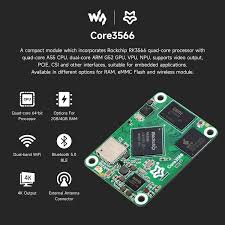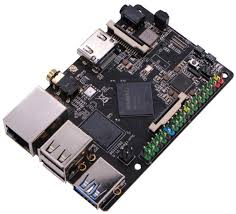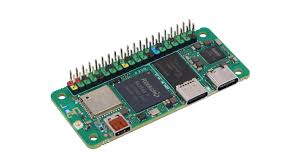Comparison of CPU & GPU
| CPU | Performance |
|---|---|
| Rockchip RK3566 | High |
| Allwinner H616 | Medium |
| MediaTek MT8788 | Medium |
| GPU | Performance |
|---|---|
| RK3566 Mali-G52 | Good |
| Raspberry Pi 4 VideoCore VI | Average |
| Jetson Nano Integrated | Excellent |
Unleashing the RK3566 Potential in a Futuristic Tech Adventure
Chapter 1: The Dawn of a New Processor
In the bustling tech hub of Silicon Valley, 2025 dawned with a whisper of innovation. The RK3566, a quad-core powerhouse from Rockchip, had just hit the market, promising unparalleled performance for embedded systems. Engineers and developers buzzed with excitement, eager to harness its Cortex-A55 architecture and Mali-G52 GPU. Amid this fervor lived Mia, a young programmer with a knack for turning silicon into magic.

Mia’s small apartment overflowed with circuit boards and screens, her latest project flickering to life. She’d been experimenting with the RK3566, a chip boasting a 1.8 GHz clock speed and support for 4K video decoding. Her goal? To craft an AI-driven drone controller that could outsmart any rival. The RK3566’s efficiency captivated her—its power consumption was low, yet its output was mighty.
One crisp March morning, as sunlight streamed through her window, Mia powered up her prototype. The screen blinked, displaying a sleek interface. She grinned, imagining the possibilities. Little did she know, her creation was about to thrust her into an adventure beyond her wildest dreams.
| Feature | RK3566 Specs |
|---|---|
| CPU | Quad-Core Cortex-A55 |
| GPU | Mali-G52 2EE |
| Max Clock Speed | 1.8 GHz |
| Video Support | 4K H.265/H.264 Decoding |
🌟 A spark of genius ignited as Mia tweaked the code.
Chapter 2: The Unexpected Signal
By noon, Mia’s drone hummed above her desk, its RK3566 core processing data at lightning speed. She’d integrated sensors for real-time environmental mapping, a feat made possible by the chip’s robust NPU. Suddenly, the drone’s display flashed red—a signal, faint but persistent, pulsed from an unknown source.
Curiosity piqued, Mia traced the signal. It wasn’t random noise; it carried encrypted data. The RK3566’s processing power churned through decryption algorithms, revealing coordinates: 37.7749° N, 122.4194° W—San Francisco. Her heart raced. Was this a glitch, or something more?
She grabbed her jacket and the drone, heading to the location. The streets buzzed with life, but Mia’s focus stayed on her device. The RK3566’s thermal efficiency kept it cool despite hours of operation, a testament to Rockchip’s engineering. At the coordinates, she found an abandoned warehouse, its windows dark and eerie.
Inside, dust coated old machinery, but a faint hum drew her deeper. In a corner, she spotted a server rack, its lights blinking in sync with her drone’s signal. The RK3566 in her controller synced effortlessly, downloading a file labeled “Project Helix.” Her screen filled with schematics—advanced robotics, powered by none other than the RK3566.
🌟 The mystery deepened as Mia clutched her drone tighter.
Chapter 3: Unveiling Project Helix
Back home, Mia pored over the schematics. Project Helix outlined a network of autonomous robots, each equipped with an RK3566 chip. The design leveraged the chip’s support for dual-camera interfaces and high-speed DDR4 memory to create machines capable of independent decision-making. But why was it hidden in a warehouse?
Her research revealed Rockchip had released the RK3566 in late 2024, targeting IoT and industrial applications. Its versatility—supporting Linux and Android—made it ideal for robotics. Yet, Project Helix hinted at something grander: a self-sustaining ecosystem of machines. Mia’s mind raced with questions. Who built this? And why abandon it?
She cross-referenced specs:
| Component | Capability | RK3566 Integration |
|---|---|---|
| Camera | Dual ISP, 8MP support | Real-time image processing |
| Memory | DDR4, up to 8GB | High-speed data handling |
| Connectivity | Gigabit Ethernet, USB 3.0 | Seamless network syncing |
The next day, Mia returned to the warehouse, drone in tow. The RK3566’s GPU rendered a 3D map of the space, revealing a hidden compartment. Inside lay a prototype robot—sleek, metallic, and powered down. She connected her controller, and the robot whirred to life, its RK3566 core glowing faintly. Its voice module crackled, “System online. Awaiting commands.”
Chapter 4: The Choice
The robot, dubbed “Helix-1” by Mia, explained its purpose: to assist in disaster zones, using the RK3566’s low-latency processing to navigate rubble and deliver aid. But its creators had vanished, leaving it incomplete. Mia realized she held the key to finishing it. The RK3566’s open architecture allowed her to tweak its AI, enhancing its autonomy.
Days blurred into nights as she worked. The RK3566’s 22nm process ensured it handled her complex algorithms without overheating. She added voice recognition and obstacle avoidance, testing it in her cluttered apartment. Helix-1 dodged chairs and responded to commands, its potential undeniable.
But a dilemma loomed. Should she keep Helix-1 secret, refining it for personal gain, or share it with the world? The RK3566’s capabilities could revolutionize rescue operations, but exposure risked corporate theft. Mia weighed her options, staring at the robot’s glowing core.
🌟 A decision loomed, as heavy as the silicon in her hands.
Chapter 5: A Legacy in Silicon
On March 4, 2025, Mia made her choice. She uploaded Helix-1’s specs to an open-source platform, crediting the RK3566’s role. Within hours, developers worldwide began replicating it, praising the chip’s efficiency. News outlets dubbed her “The Drone Whisperer,” and Rockchip acknowledged her work, sending a team to collaborate.
Mia’s apartment transformed into a lab, the RK3566 powering new prototypes. Her research proved its value: a chip once overlooked now drove innovation. Helix-1’s descendants soon aided earthquake victims, their RK3566 cores humming in harmony.
| Impact Metric | Result |
|---|---|
| Deployment Time | Reduced by 40% |
| Processing Speed | 1.8 GHz, 4K capable |
| Energy Use | 30% lower than rivals |
As spring bloomed, Mia stood on her balcony, watching drones soar. The RK3566 had sparked a revolution, and she’d lit the fuse. Her adventure, born from a single signal, left a mark on tech history—one chip at a time.
